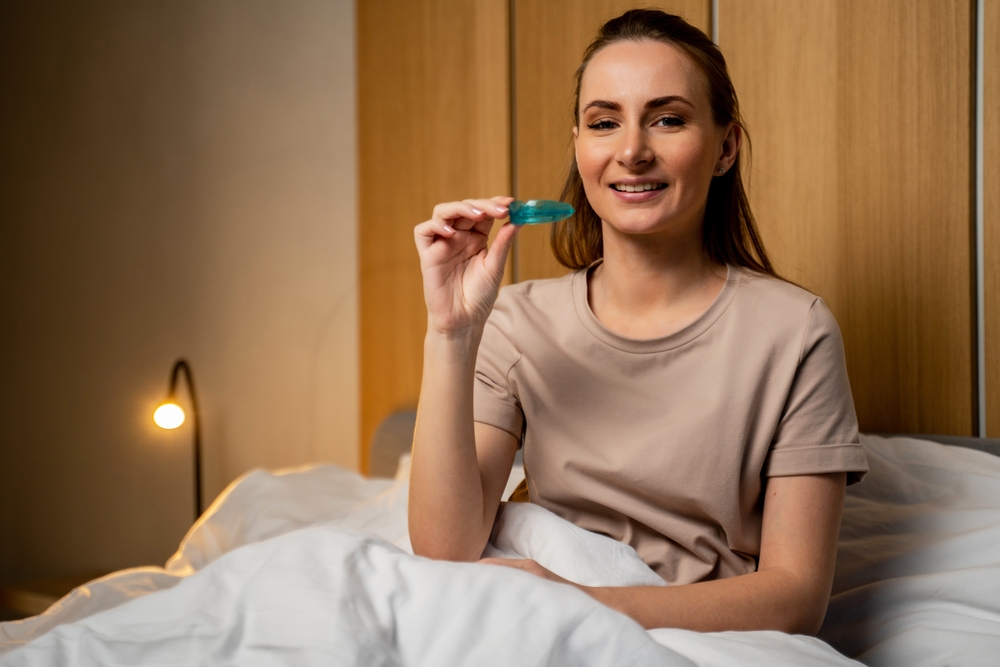If you struggle with loud snoring, restless nights, or chronic fatigue, sleep apnea might be the culprit. While many people associate sleep apnea with medical devices like CPAP machines, few realize that a dentist can play a pivotal role in treatment. Because the structure of your mouth and jaw directly affects your airway, dental professionals are uniquely positioned to offer solutions that not only improve your sleep but also enhance your smile. In this blog, we’ll explore how a cosmetic dentist can help manage sleep apnea using customized oral appliances and dental treatments that support both function and aesthetics.
In This Blog:
- Understanding Sleep Apnea and Its Symptoms
- The Role of Oral Structures in Sleep Apnea
- How a Dentist Diagnoses Sleep Apnea
- Oral Appliance Therapy as a Cosmetic and Functional Solution
- The Aesthetic Bonus: Smile Enhancements That Aid Breathing
- When Oral Appliances Work Better Than CPAP
Understanding Sleep Apnea and Its Symptoms
Sleep apnea is a serious sleep disorder that causes repeated interruptions in breathing during the night. The most common form, obstructive sleep apnea (OSA), occurs when the muscles at the back of the throat relax too much, leading to airway blockage. These breathing pauses can last several seconds and may occur dozens or even hundreds of times per night.
Common symptoms of sleep apnea include loud snoring, choking or gasping during sleep, morning headaches, dry mouth, and excessive daytime fatigue. Over time, untreated sleep apnea can increase the risk of high blood pressure, heart disease, stroke, and type 2 diabetes. It can also take a toll on mental health, mood, and overall quality of life. Recognizing these signs early and seeking help is crucial for restoring restful sleep and long-term wellness.
The Role of Oral Structures in Sleep Apnea
Many people don’t realize that the shape and position of oral and facial structures play a major role in sleep apnea. The size of your jaw, the position of your tongue, and the alignment of your teeth can all contribute to airway obstruction during sleep. For example, a narrow palate, recessed lower jaw, or crowded teeth can push the tongue backward and reduce space in the throat.
Cosmetic dentists often work with patients to address these structural issues, not only to enhance appearance, but also to improve function. Treatments that adjust jaw position or align the bite can help open the airway and reduce sleep apnea symptoms. By combining aesthetic improvements with functional care, cosmetic dentists provide a holistic approach to managing this condition.
How a Dentist Diagnoses Sleep Apnea
While a definitive diagnosis of sleep apnea typically comes from a sleep physician using a sleep study, dentists, especially those trained in dental sleep medicine, are often the first to spot signs of the condition. During a routine exam, a dentist may notice indicators such as worn teeth from nighttime grinding (bruxism), a scalloped or enlarged tongue, a narrow dental arch, or jaw misalignment. These features can suggest a compromised airway.
If sleep apnea is suspected, your Cromwell dentist may refer you for a sleep study or collaborate with a sleep specialist for proper evaluation. Once confirmed, your dentist can recommend oral appliance therapy as an alternative or complement to other treatments.
Oral Appliance Therapy as a Cosmetic and Functional Solution
One of the most effective ways a dentist can help manage sleep apnea is through custom-fitted oral appliances. These devices, known as mandibular advancement devices (MADs), are worn during sleep to gently reposition the lower jaw and tongue forward, keeping the airway open and preventing obstruction.
Unlike CPAP machines, oral appliances are compact, silent, and easy to wear, making them a preferred solution for many patients. Beyond their functional benefits, these appliances can also have cosmetic advantages. By subtly adjusting the jaw position, they may improve facial symmetry and reduce muscle strain, contributing to a more relaxed and youthful appearance. With precise fit and design, these dental solutions offer a comfortable, non-invasive way to address both sleep apnea and cosmetic concerns.
The Aesthetic Bonus: Smile Enhancements That Aid Breathing
Cosmetic dental treatments aren’t just about creating a beautiful smile, they can also improve airway function. For example, orthodontic solutions like Invisalign or clear aligners can correct bite issues and gently widen the dental arch, which can make more room for the tongue and reduce airway obstruction. Similarly, palatal expansion in adults can open the upper jaw and nasal passages, enhancing both breathing and facial harmony.
In some cases, dental reshaping or restorative procedures such as crowns or veneers can support proper jaw alignment and contribute to a more functional bite. These improvements not only make your smile more attractive but can also alleviate stress on oral structures involved in sleep apnea. The result is a dual benefit: you breathe easier and feel more confident about your appearance.
When Oral Appliances Work Better Than CPAP
Continuous Positive Airway Pressure (CPAP) therapy is the standard treatment for moderate to severe obstructive sleep apnea, but many patients find it difficult to tolerate. CPAP machines can be bulky, noisy, and uncomfortable, often leading to poor compliance. For individuals with mild to moderate sleep apnea, or those who can’t use CPAP consistently, oral appliance therapy offers an appealing alternative.
Dental sleep appliances are custom-made, discreet, and easy to travel with. They don’t require electricity or a mask and are often better tolerated long-term. Cosmetic dentists can ensure that the device fits comfortably, functions effectively, and doesn’t compromise the appearance of your smile. For many, it’s a practical, attractive solution that promotes better sleep and supports overall wellness without the drawbacks of traditional equipment.
Conclusion
Sleep apnea is more than just snoring, it’s a serious condition that can affect your health, appearance, and quality of life. Fortunately, cosmetic dentists are uniquely equipped to offer solutions that do more than improve your smile. Through personalized oral appliance therapy, bite correction, and airway-focused treatments, your dentist can help you breathe better, sleep soundly, and look your best. If you’ve been struggling with sleep issues or have been diagnosed with sleep apnea, it’s time to explore how dental care can make a difference.
Ready to take the next step toward better sleep and a healthier smile? Contact Smile Drs in Cromwell today to schedule a consultation and find out if oral appliance therapy is right for you. Your journey to restful nights and renewed confidence starts here.



